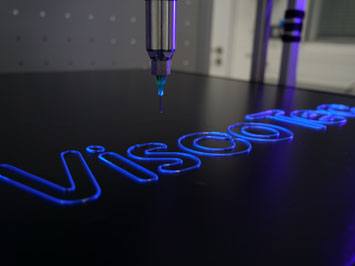Sealants applied to components primarily serve to protect sensitive components. They protect against external influences such as dust or moisture. By using sealants and adhesives, a multifunctional connection is possible due to the additional joint – in contrast to classic pre-assembled seals. A precise overlapping of the beginning and end of the closed sealing bead is essential to ensure homogeneous force transmission and tightness of the joint. ViscoTec dispensers have proven themselves in numerous dispensing tests and applications for the application of highly viscous materials.

Dispensing of 1-component acrylic adhesive from DELO using a ViscoTec dispenser
In industrial production, a distinction is made between two processes for the application of liquid seals: The “Cured-In-Place Gasket” (CIPG) and the “Formed-In-Place Gasket” (FIPG). In the case of the CIPG process, further processing of the component takes place only after the sealant has cured. In the case of the FIPG process, on the other hand, the component is joined with the not yet crosslinked liquid seal and further processed. A sealant that is perfectly suitable for both processes is the highly viscous and stable 1-component UV and light-curing acrylic adhesive PHOTOBOND SL4165 from DELO.
In order to guarantee the tightness of the dispensing bead, the material must be applied precisely and with repeat accuracy along the sealing contour. By using ViscoTec dispensers, even complex geometries can be dosed without any problems despite different dosing speeds. The programmable suck-back prevents dripping and contamination of the component or seal. Furthermore, the possibility of endless dispensing makes it easy to achieve different seal sizes and shapes and to adapt production without major difficulties.
The 1-component acrylic adhesive is used, for example, in the electrical and electronics industry, in the field of e-mobility and in the automotive industry. In applications such as the sealing of casings, motors, gears and sensors, the classic sealing process is increasingly being replaced by sealing with an additional adhesive function. This development has clear advantages: The user can be more flexible in the design of the sealing bead. And the costs for storage and the time required for assembly are eliminated.
Video to the application:
The post Dispensing of 1-component Acrylic Adhesive appeared first on ViscoTec Pumpen- u. Dosiertechnik GmbH.

